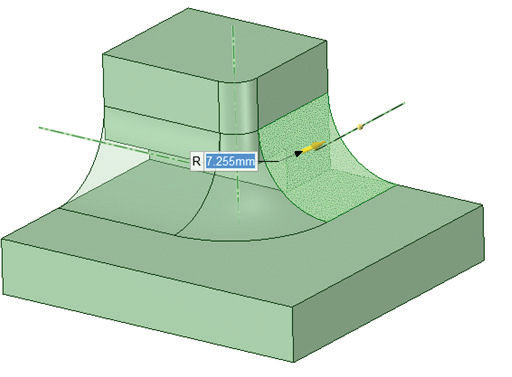Editor’s Pick: ANSYS Releases SpaceClaim 2015

This screen shot depicts creating rounds directly as surfaces with ANSYS SpaceClaim 2015. Image courtesy of ANSYS Inc.
Latest News
November 26, 2014
 Dear Desktop Engineering Reader:
Dear Desktop Engineering Reader:
 ANSYS has just released the 2015 version of its ANSYS SpaceClaim direct modeling solution. This is the first major release of the software since ANSYS acquired SpaceClaim Corp. this past May. At that time, industry talking heads speculated at what the transaction meant. Well, some of the contours of what ANSYS is up to appear in this release, and they seem to be good news for devotees of both SpaceClaim and ANSYS analysis tools.
ANSYS has just released the 2015 version of its ANSYS SpaceClaim direct modeling solution. This is the first major release of the software since ANSYS acquired SpaceClaim Corp. this past May. At that time, industry talking heads speculated at what the transaction meant. Well, some of the contours of what ANSYS is up to appear in this release, and they seem to be good news for devotees of both SpaceClaim and ANSYS analysis tools.
As you might expect, SpaceClaim has a lot of new and improved integration with the ANSYS tool suite. It has tighter integration with the ANSYS Workbench platform and ANSYS DesignModeler for geometry handling for analysis as well as a direct connection with the ANSYS HFSS software for simulating 3D full-wave electromagnetic fields. ANSYS Workbench is key here.
ANSYS Workbench is the framework that serves as the foundation of ANSYS’ suite of advanced engineering simulation technology. It ties together the simulation process, uses drag-and-drop processes to guide you through multiphysics analysis and provides automated meshing and a host of other capabilities.
What the SpaceClaim and ANSYS Workbench integration means for analysts is that you can easily do a lot of your own geometry prep using SpaceClaim’s direct modeling tools. That means you will not have to be hassling the CAD people to convert a model for you, which will make them happy. SpaceClaim 2015 also has some other tools to do its part in simulation-driven design. Among these are new simulation cleanup and detection tools for short edges, overlap faces and corrupt faces as well as tools that provide better control over connections between parts.
ANSYS SpaceClaim remains a direct modeler, and the 2015 edition sees improvements in this area. In no particular order, these include a blend to point capability, tangent/natural extensions for curves and surfaces, variable radius rounds and re-ordering of overlapping round chains.
SpaceClaim’s 3D Printing module now includes more tools for repairing models and analyzing print jobs. You can use SpaceClaim’s direct editing pull and move tools on meshes, which should make it faster and easier to set up models for 3D printing. There’s also a new plugin for MakerBot uploads.
Machine improvements include a new relief tool for making cutouts at sharp corners automatically. SpaceClaim 2015 has new deburring and lathe profile creation tools for generating toolpaths and extends support to Mastercam X8. Speaking of support, it also has updated import support for more file types, including JT and CATIA, as well as extended support for the current versions of major CAD applications like Solid Edge and Inventor.
Sheet metal has been a SpaceClaim strength, and that grows in this release. Version 2015 offers upgrades like swept walls, rounded louvers, split of blend junctions, and configurable junction gaps. It also has support for editing of U-shaped bends, fold up of individual walls and user-defined wall overlap percentages.
ANSYS SpaceClaim 2015 has a lot of other things going on for it. For example, it now lets you create custom shortcuts so that you can personalize SpaceClaim tools to your needs.
The short of this first release is that it seems ANSYS is letting SpaceClaim evolve naturally as a tool while bringing it into its simulation-driven design family for more analysts to use. And that’s a good thing for everybody.
You can learn more about ANSYS SpaceClaim 2015 from today’s Pick of the Week write-up. Make sure to hit the link to sign up for an evaluation unit. SpaceClaim has always been a fun tool to use. The first release from ANSYS seems like it’ll be true to that tradition.
Thanks, Pal. — Lockwood
Anthony J. Lockwood
Editor at Large, Desktop Engineering
Read today’s pick of the week write-up.
This is sponsored content. Click here to see how it works.
Subscribe to our FREE magazine, FREE email newsletters or both!
Latest News
About the Author
Anthony J. Lockwood is Digital Engineering’s founding editor. He is now retired. Contact him via [email protected].
Follow DE





